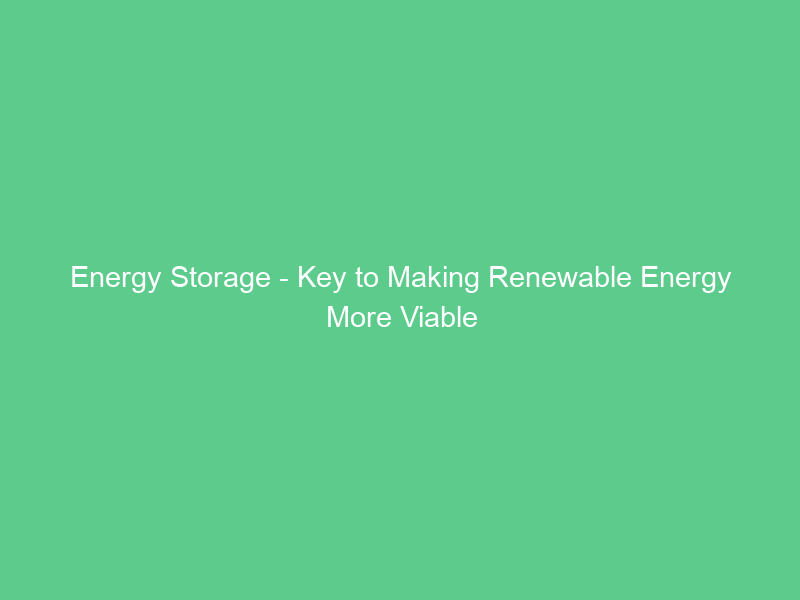Energy storage is key to making renewable energy more economically feasible, helping balance electricity supply and demand over multiple timescales, thus lowering customer costs of renewable generation by preventing price spikes during periods of peak demand.
Energy storage technologies include lithium-ion batteries at the utility scale, compressed air energy storage (CAES), supercapacitors, and thermal energy storage – technologies which can be deployed within communities to increase resilience while alleviating strain on electrical grids.
Rechargeable Batteries
Rechargeable batteries found in smartphones are all too familiar, as are AA or AAA batteries found powering flashlights, children’s toys, and other low-power devices. When properly disposed of at battery drop-off points they help keep toxic metals out of landfills and the environment.
Grid storage requires batteries with the appropriate scale and depth of discharge (DOD), necessitating new generations of battery technologies. BES scientists are developing these innovative products while researching electrochemical phenomena on an atomic and molecular level in order to create materials which last longer, charge faster, and perform better over time.
These new technologies could help manage electricity demand peaks and valleys more effectively, replacing fossil fuel plants while potentially saving people money on their energy bills.
Flow Batteries
Flow batteries differ from lithium-Ion systems in that they do not contain an internal battery body; rather, they consist of stacks of cells where energy conversion takes place; electrolyte tanks that store solutions carrying and storing energy; piping for solution circulation and piped energy storage tanks to store energy in. They can be expanded more quickly by expanding either their number of power stacks, concentration of solutions or size of storage tank sizes compared to lithium-Ion systems.
Redox flow battery technologies vary, with some based on vanadium and iron, using an oxidizer such as Nitrilotri-methylphosphonic Acid (NTMPA), which is nontoxic and often used to prevent corrosion in water treatment plants. Already these batteries are being deployed behind-the-meter for manufacturing facilities, campuses, and hospitals looking to take part in demand response energy curtailment programs during high rate tariff periods to help lower peak power demands and cut peak costs.
Supercapacitors
Supercapacitors provide an attractive force solution for many applications. Their advantages include high charge/discharge current capacity, exceptional efficiency and wide temperature range. In addition, supercapacitors consume less power when in operation and can be discharged in seconds making them perfect for powering uninterruptible power supplies (UPSs) and electronic devices.
Supercapacitors can achieve specific powers that are 10-100 times greater than batteries, often exceeding 140 Wh/kg, due to electrostatic double-layer capacitance and electrochemical pseudocapacitance effects.
Supercapacitor market success relies upon a set of practical industry standards – both national and international. This should include terms, classification model naming method, electrical performance test methods, safety technical requirements, charging specification series series series production requirements as well as transportation, recovery and destruction requirements.
Compressed Air Energy Storage (CAES)
This energy storage technology employs electricity to compress air stored underground caverns. When needed, this air is released and expanded back out again in order to generate power – this solution is particularly suitable for intermittent renewable sources like wind and solar.
As with other forms of energy storage, there can be tradeoffs between storage size, efficiency and power density. Expanding storage size consumes more energy while ineffective compression/expansion can result in significant losses. However, quasi-isothermal systems offer an advantageous solution by taking advantage of low temperature ocean storage sites to reduce both compression/expansion costs simultaneously.
McIntosh and Huntorf plants are examples of CAES currently in operation, though due to geographical requirements (e.g. suitable underground formations) these systems may not be as widely available than other technologies.
Thermal Energy Storage (TES)
Heating, ventilation and air conditioning account for an important portion of building energy usage. Renewable powered thermal storage offers one way to meet this demand: grid integration through intermittent power or flexible sector coupling can meet this need.
TES systems differ from batteries by using less expensive and geopolitically sensitive raw materials that can be located almost anywhere. Their components can be configured for daily or seasonal storage needs as well as peak shaving, load shifting or power-to-heat adaptation features.
NREL is working closely with research-and-development partners Antora Energy, Electrified Thermal and KraftBlock to create thermal energy storage (TES) systems capable of low cost heat or electricity delivery. This work will enable hybrid thermal-electric solutions tailored to specific building requirements.

